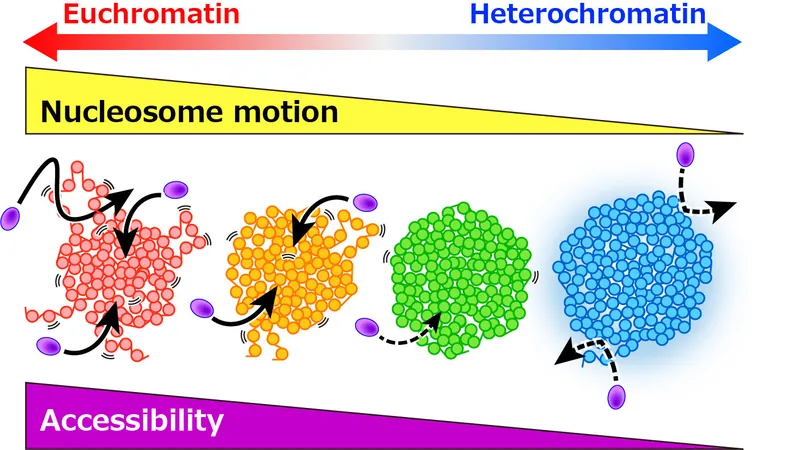
Shocking Revelation: How Our DNA is Masterfully Packed Inside Cells!
2025-04-01
Author: Rajesh
A groundbreaking study from Japan has unveiled remarkable insights into the organization of our DNA within cells, revealing previously hidden dynamics of chromatin, the material that makes up our chromosome structures.
Under the guidance of Professor Kazuhiro Maeshima from the National Institute of Genetics, the research team introduced a revolutionary technique known as "Repli-Histo labeling," which allows for the visualization of chromatin in live cells — a feat that has daunted scientists for years. Published on March 28 in the journal *Science Advances*, this research reshapes our understanding of genetic regulation.
Did you know that every human cell houses a staggering 2 meters of DNA, which must be meticulously coiled within a minuscule nucleus?
This intricate spatial arrangement is achieved through chromatin, composed of DNA wrapped around proteins. Chromatin exists primarily in two forms: euchromatin, where genes are actively expressed, and heterochromatin, where gene expression is silenced. But how do these chromatin types actually behave within the bustling environment of a living cell? Until now, this question remained largely unanswered.
Katsuhiko Minami, the lead author of the study, states, 'We lacked a method to specifically label euchromatin and heterochromatin in living cells.'
Enter Repli-Histo labeling, which distinguishes between these two forms of chromatin, revealing that euchromatin is far more fluid and dynamic compared to its heterochromatic counterpart, which behaves more like a gel, creating a rigid barrier against molecular entry.
This pivotal discovery implies that euchromatin's flexible nature allows for the quick movement of proteins and other molecules, facilitating necessary interactions with genes crucial for pivotal cellular processes like gene expression and DNA replication.
Conversely, the static form of heterochromatin acts as a blockade, limiting access to certain genes, which could contribute to how cells regulate their functional behaviors.
Dr. Kako Nakazato, a co-author of the research, emphasizes the significance of these findings: 'Understanding chromatin behavior is vital for grasping how cells determine which genes are active or silent.'
If chromatin is not properly balanced—either too rigid or too loose—it might lead to improper gene function.
This research marks a significant shift in the scientific perspective on chromatin—no longer viewed merely as a static container but as an active participant in gene regulation.
"In essence, chromatin is not just a storage unit for our genetic blueprint; it plays an essential role in controlling gene function," Minami further elucidates.
Looking ahead, the researchers hope to develop a comprehensive chromatin behavior atlas to visualize how various factors, including epigenetic modifications, influence chromatin dynamics.
"Our ultimate aim is to decode how the extensive genome, neatly housed within 2 meters of DNA, is meticulously managed within a compact nucleus," states Maeshima.
This research not only paves the way for a deeper understanding of healthy gene function but also holds transformative potential for addressing dysfunctions associated with diseases, including cancer.
Stay tuned as we continue to explore the mysteries of our genetic landscape!



 Brasil (PT)
Brasil (PT)
 Canada (EN)
Canada (EN)
 Chile (ES)
Chile (ES)
 Česko (CS)
Česko (CS)
 대한민국 (KO)
대한민국 (KO)
 España (ES)
España (ES)
 France (FR)
France (FR)
 Hong Kong (EN)
Hong Kong (EN)
 Italia (IT)
Italia (IT)
 日本 (JA)
日本 (JA)
 Magyarország (HU)
Magyarország (HU)
 Norge (NO)
Norge (NO)
 Polska (PL)
Polska (PL)
 Schweiz (DE)
Schweiz (DE)
 Singapore (EN)
Singapore (EN)
 Sverige (SV)
Sverige (SV)
 Suomi (FI)
Suomi (FI)
 Türkiye (TR)
Türkiye (TR)
 الإمارات العربية المتحدة (AR)
الإمارات العربية المتحدة (AR)